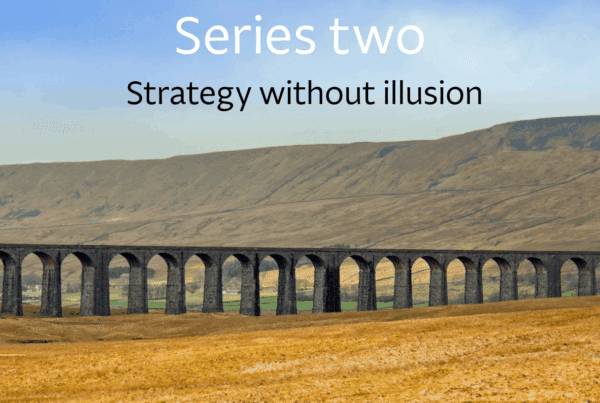Strategy Without Illusion: Series Wrap-Up
Final thoughts from the touchline
Most strategies don’t fail because the strategic thinking was wrong. They fail because the strategic alignment was shallow, the multiplication rhythm wasn’t systematically established, and the capability to translate strategic knowledge into operational results wasn’t genuinely shared throughout the organisation.
This series has explored that gap: the space between signed-off strategic plans and systematic strategic execution through The Strategic Multiplication Framework™. Not to assign blame, but to provide systematic solutions. Because it’s in that translation gap that most strategic underperformance begins, and where systematic multiplication capability can make the decisive difference.
As an Interim CEO, Chair, and Executive Coach, I’ve been brought in when strategic execution cracks are already showing. What I’ve learned across these three pathways is this: strategic success doesn’t come from sophisticated strategy documents or detailed tactical plans. It comes from systematic strategic clarity, execution discipline, and ongoing strategic conversation that builds multiplication capability throughout the organisation.
Success comes from strategic alignment that’s systematically maintained through operational complexity, not just assumed after initial planning agreement. From strategic execution that is systematically planned, constructively challenged, and systematically adapted as conditions change whilst maintaining strategic intent.
The early signs of strategic multiplication breakdown
In practice, the signs of strategic drift appear earlier than most leaders recognise, but they’re predictable if you know what systematic signals to watch for.
Strategic progress stalls despite continued tactical activity. Organisational energy around strategic outcomes drains even when functional performance continues. Strategic updates become transactional reporting rather than strategic coordination conversations. Strategic metrics lose operational meaning because they’re not connected to systematic decision-making criteria.
These aren’t tactical execution failures. They’re systematic multiplication failures. They signal that strategic intent, while intellectually approved, isn’t systematically alive in operational decision-making throughout the business.
From the touchline perspective as Chair, NED, Portfolio Manager, CEO, or Managing Director, the role isn’t to create strategic plans tactically. It’s to systematically assess where strategic belief is fading operationally, where structural friction is undermining strategic coordination, and where operational silence has replaced constructive strategic challenge.
That’s where real strategic multiplication contribution happens: not in the strategic plan’s initial approval, but in how systematically it lives and multiplies through organisational decision-making afterward.
What the series covered systematically
Why Most Board-Approved Plans Never Deliver. The illusion of strategic alignment and why so many strategically sound plans stall before systematic multiplication begins. How financial agreement differs fundamentally from strategic intent clarity, and why strategic execution requires systematic translation of strategic knowledge into operational decision-making criteria.
You Don’t Need a New Strategy: You Need Follow-Through. Why systematic strategic execution, not strategic reinvention, is usually the missing piece. How strategic persistence through systematic multiplication builds competitive advantage that strategic pivoting rarely achieves. Why building systematic execution capability matters more than developing new strategic direction.
When Strategy is Clear but Performance Lags. Why strategically clear plans naturally drift without systematic multiplication capability, and how touchline leaders can systematically re-anchor strategic progress through operational coordination. The difference between strategic understanding and systematic strategic execution capability.
Three Questions Every NED Should Ask Before Signing Off a Growth Plan. The systematic questions that assess multiplication readiness rather than just strategic planning quality. How to test for systematic strategic execution capability before operational momentum makes strategic course correction more difficult.
The systematic takeaway for multiplication leaders
If there’s one systematic insight from this series, it’s this: Don’t mistake intellectual agreement for systematic strategic alignment. Don’t mistake tactical activity for systematic strategic execution. And don’t mistake a signed-off strategic plan for systematic multiplication capability.
Strategic alignment requires systematic operational coordination around strategic intent, not just meeting agreement on strategic direction. Strategic execution requires systematic translation of strategic knowledge into operational decision-making capability, not just tactical activity coordination. Strategic plans require systematic multiplication capability to translate strategic thinking into operational results consistently.
The Strategic Multiplication Framework™ solution
This series has demonstrated that the gap between strategic planning and strategic results is systematic, predictable, and solvable through The Strategic Multiplication Framework™ approach.
Strategic intent clarity that translates into operational decision-making guidance rather than just aspirational strategic direction. Teams understand not just what strategic success looks like, but how their operational choices should systematically support strategic outcomes.
Capability multiplication that builds collective strategic execution ability rather than just improving individual tactical performance. Organisations develop systematic approaches to coordinating individual capabilities around strategic outcomes that compound over time.
Adaptive decision-making that maintains strategic alignment whilst responding to operational complexity. Teams can systematically adjust tactical approaches whilst maintaining strategic direction because they understand strategic intent clearly enough to make consistent operational decisions independently.
Performance acceleration that builds strategic momentum through systematic execution rather than tactical pressure. Results improve systematically because organisational capability to translate strategic thinking into operational coordination improves consistently over time.
From touchline leadership to systematic multiplication
From the touchline, multiplication leadership is about systematically listening for strategic signals, asking questions that build strategic thinking capability, and quietly protecting the systematic conditions that enable strategic performance rather than just monitoring strategic progress.
It’s about building systematic organisational capability to maintain strategic focus amid operational complexity. Creating systematic strategic conversation that develops collective strategic thinking rather than just communicating strategic direction. Establishing systematic rhythm that keeps strategic intent alive in operational decision-making when tactical urgency naturally diffuses strategic attention.
The multiplication effect is measurable: organisations that develop systematic strategic execution capability through The Strategic Multiplication Framework™ achieve strategic objectives more consistently, adapt to market changes whilst maintaining strategic direction, and build competitive advantages that compound over time through enhanced collective capability.
The systematic competitive advantage
Organisations that master systematic strategic multiplication through The Strategic Multiplication Framework™ develop competitive advantages that are difficult for rivals to copy because the advantages are embedded in systematic organisational capability rather than individual strategic thinking or tactical execution.
They build strategic momentum that compounds through systematic capability development rather than requiring constant strategic pressure or tactical management. They create strategic resilience that maintains strategic direction even when operational conditions change because systematic multiplication capability adapts strategic execution whilst preserving strategic intent.
They develop strategic confidence that enables more ambitious strategic objectives over time because systematic multiplication capability transfers across different strategic challenges and market conditions.
Most importantly, they create sustainable competitive advantage through systematic strategic capability rather than just tactical excellence or strategic planning sophistication.
Continuing the multiplication journey
The Strategic Multiplication Framework™ recognises that building systematic strategic execution capability is an ongoing organisational development process, not a one-time strategic planning improvement.
For leaders operating from the touchline across Chair/NED, Interim CEO, and Executive Coach pathways, the opportunity is to systematically build multiplication capability that translates strategic knowledge into operational results consistently, regardless of specific strategic objectives or market conditions.
This systematic capability building is what distinguishes strategic success from tactical efficiency, and sustainable competitive advantage from temporary strategic gains.
The Strategic Multiplication Framework™ forms part of my strategic operations consulting approach. Working as Chair/NED, Interim CEO, or Executive Coach, I help senior management teams multiply their strategic knowledge and operational effectiveness.
Thank you for following the Strategy Without Illusion series. For systematic approaches to building strategic multiplication capability, subscribe to The Touchline Coach for frameworks that translate strategic thinking into sustainable competitive advantage.
The Series:
- Why Most Board-Approved Plans Never Deliver – The illusion of alignment and why so many strategies stall before they start.
- You Don’t Need a New Strategy — You Need Follow-Through – Execution, not reinvention, is the real missing piece.
- When Strategy is Clear but Performance Lags – Why plans drift and how touchline leaders can re-anchor progress.
- Three Questions Every NED Should Ask Before Signing Off a Growth Plan – The hard questions that protect clarity before it’s too late.


